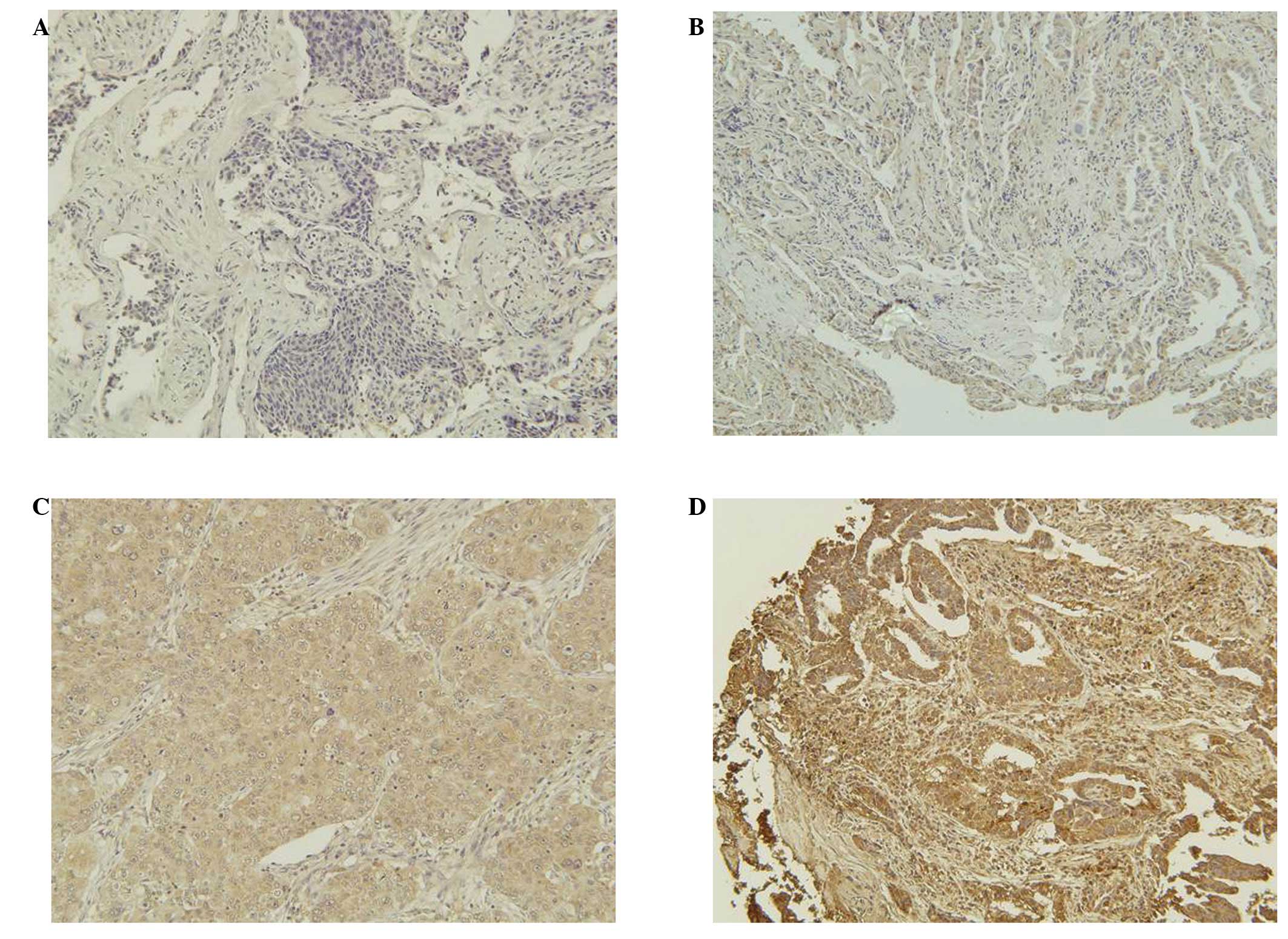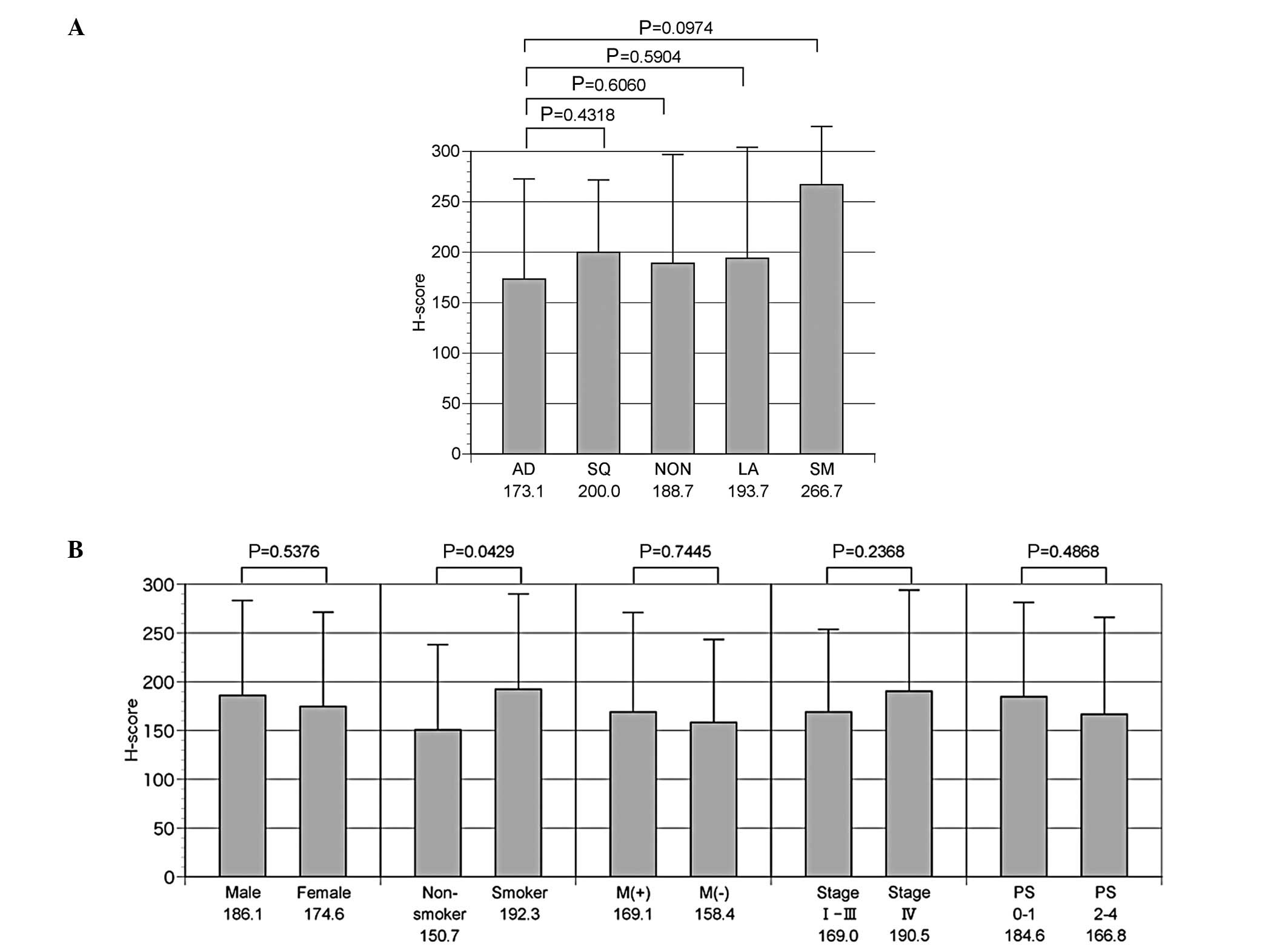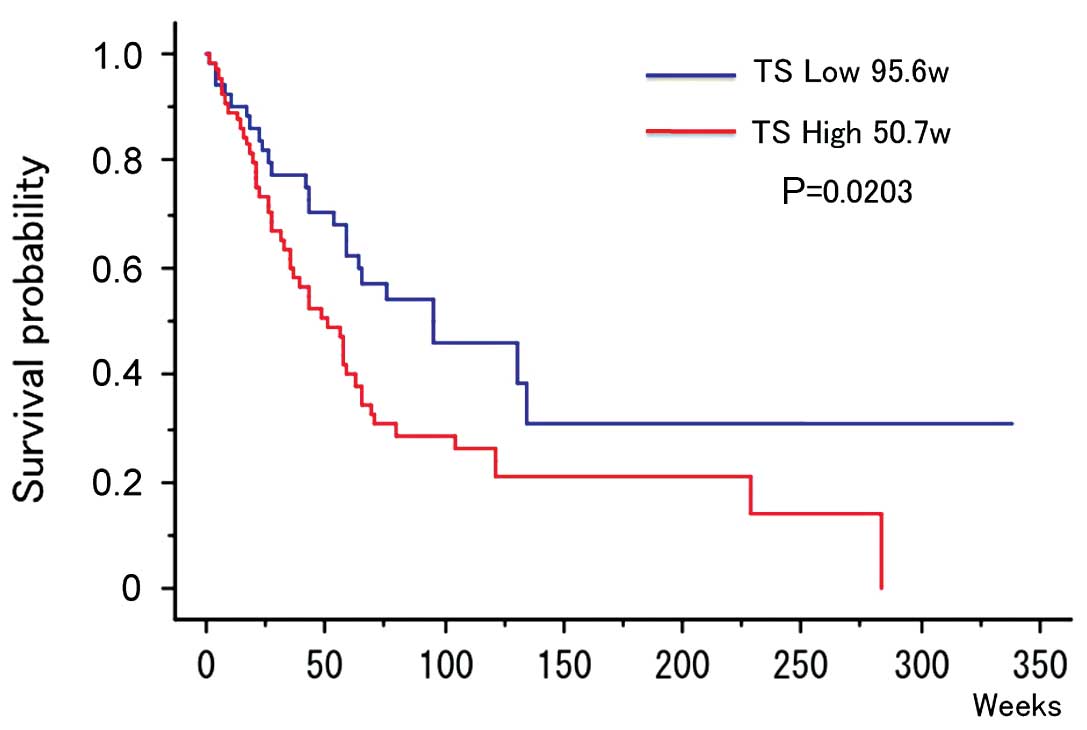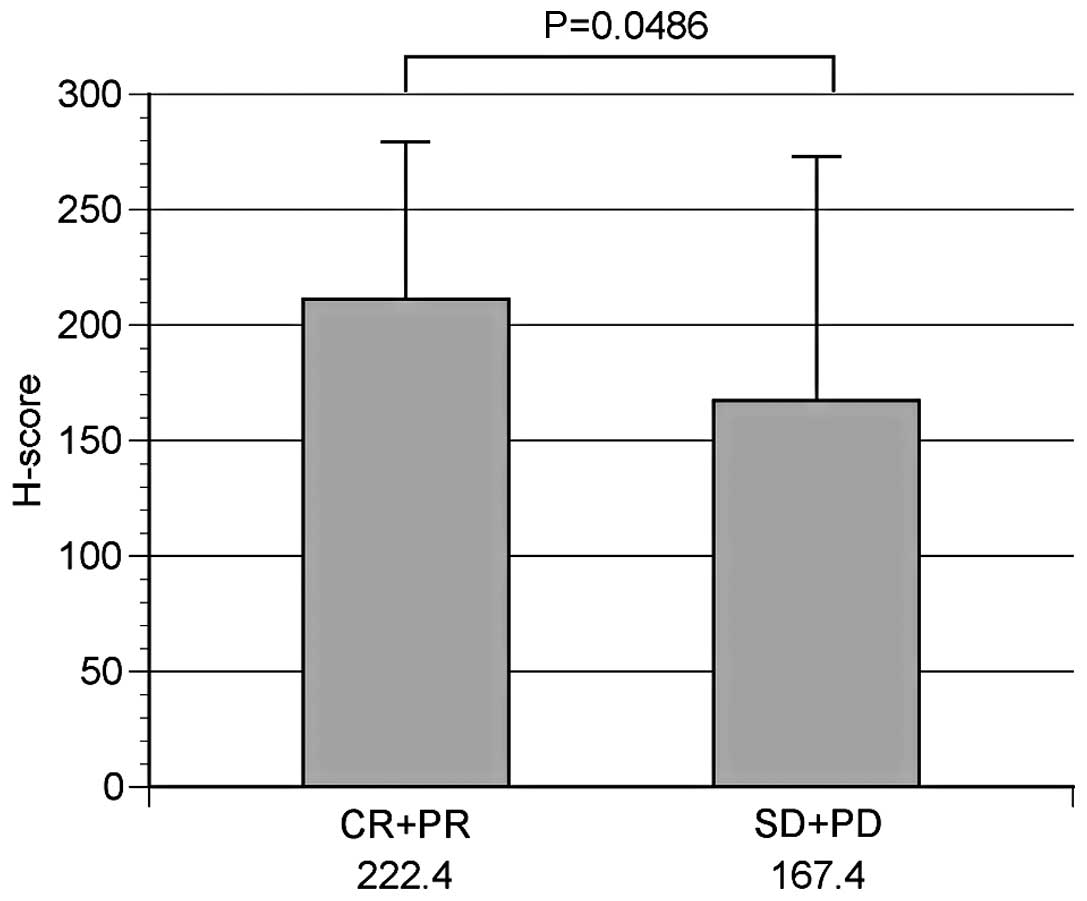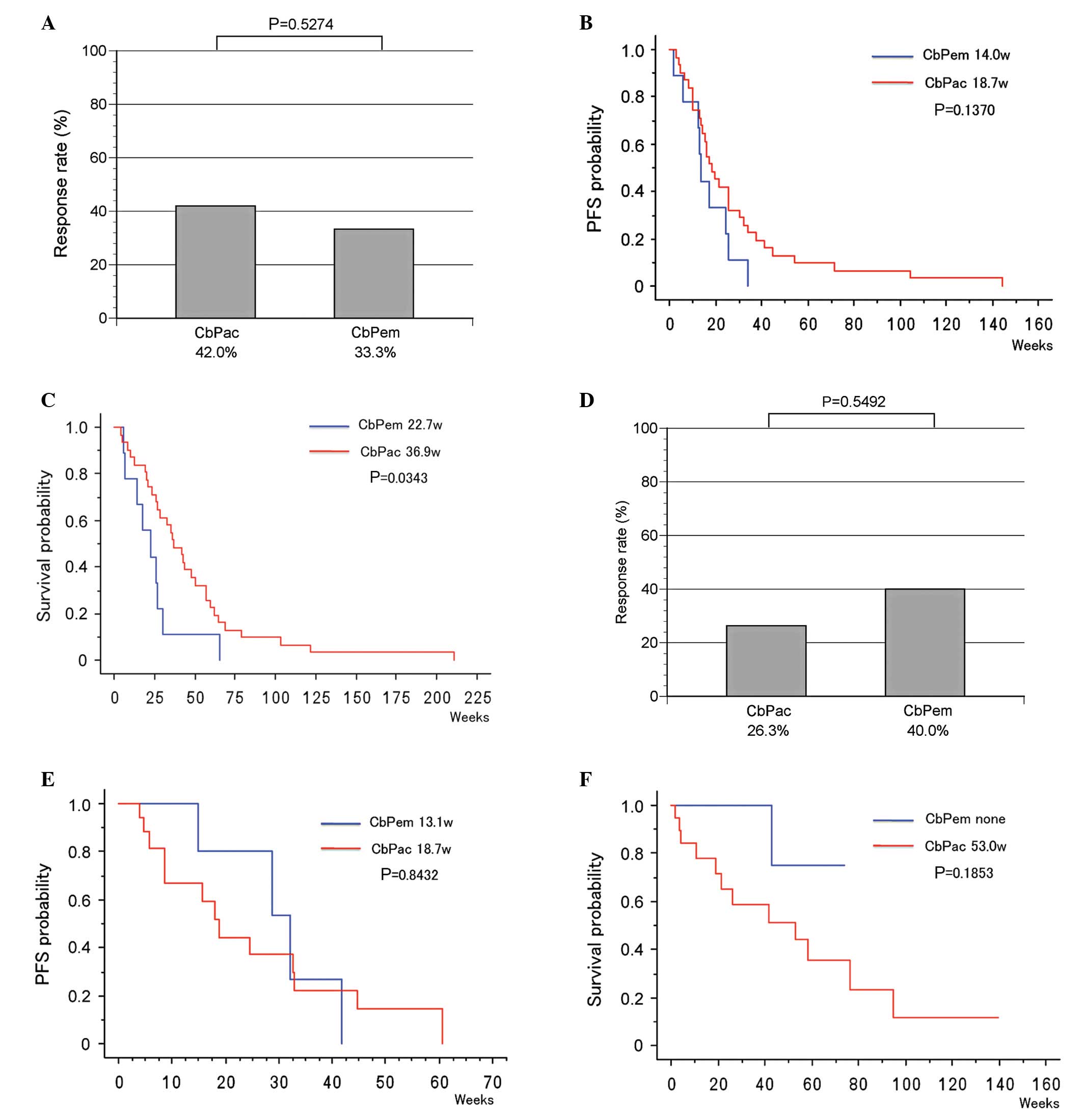Impact of thymidylate synthase protein expression on efficacy of chemotherapy in advanced lung cancer patients
- Authors:
- Published online on: March 19, 2013 https://doi.org/10.3892/mco.2013.94
- Pages: 411-417
Abstract
Introduction
Lung cancer has been the leading cause of mortality from cancer in Japan since 1998, with ∼50,000 deaths annually. Anti-smoking measures as a primary prevention strategy, early diagnosis through health-check campaigns, as well as advances in surgical therapy, chemotherapy and radiation therapy have improved overall prognosis. However, the 5-year survival rate remains at only ∼13%. Compared with other types of cancer, sufficient lung cancer therapeutic results have yet to be achieved. Lung cancer is frequently diagnosed in advanced stages, thus, the primary treatment mainly comprises platinum combination chemotherapy. Carboplatin + paclitaxel combination chemotherapy (CbPac therapy) is a typical regimen for non-small cell lung cancer (NSCLC), and is widely used in clinical practice.
The occurrence, progression and metastasis of cancer involve various gene and protein abnormalities. In lung cancer, mutations of the epidermal growth factor receptor (EGFR) and KRAS genes as well as abnormalities in protein expression have been previously reported (1–3). Recently, the correlation of these gene mutations and protein expression abnormalities with the therapeutic effects has been extensively studied, and EGFR gene mutation was identified as a predictive factor of the therapeutic effect of EGFR tyrosine kinase inhibitors (4,5).
Thymidylate synthase (TS) is a key enzyme in DNA synthesis and cell growth that has been suggested to be involved in malignancy (6–8). Moreover, it is a main target protein of antimetabolites, such as the anticancer agents pemetrexed (Pem) (9) and S-1 (10), demonstrating clinical efficacy in NSCLC. In colon (11), breast (12) and pancreatic cancer (13), an association between TS expression in cancer tissue, antitumor effects of chemotherapy and prognosis has been suggested. In lung cancer, a correlation between TS expression and prognosis has been suggested in early cancer (14). A limited number of studies have examined TS expression in advanced lung cancer, however, its impact on clinical effects remains to be determined. In particular, whether TS expression in cancer tissue is involved in the efficacy of CbPac therapy and prognosis remains to be elucidated. The aim of this study was to examine TS expression in cancer tissues obtained from patients with advanced lung cancer, and investigate the correlation between the expression rate and therapeutic effects and prognosis.
Patients and methods
Patients
In total, 120 patients diagnosed with lung cancer at Nihon University Hospital (Tokyo, Japan) between June 2004 and December 2010 were included in this study. Cancer tissue specimens were obtained from the included patients prior to treatment. The method of this study was approved by the ethics committee of Nihon University School of Medicine. Written informed consent was obtained from each subject. Cancer tissue specimens were collected by surgical procedure or bronchofiberscopic biopsy, then fixed in formalin and embedded in paraffin. Immunostaining was performed to examine the expression of TS protein. Patient background information is provided in Table I. The patients comprised 78 males and 42 females (mean age, 65.7 years). Additionally, there were 81 patients with adenocarcinoma, 17 with squamous cell carcinoma, 12 with non-small cell carcinoma, 7 with large cell carcinoma and 3 with small cell carcinoma. Eleven patients were positive for the EGFR gene mutation; performance status (PS) was 0–1 in 103 patients; the disease stage was IIIB or IV in 100 patients; and there were 29 non-smokers. The primary treatment for 85 patients (71%) was chemotherapy alone, and out of these 85 patients, 50 were administered CbPac combined chemotherapy (Table I).
TS immunostaining
Using the paraffin block of lung cancer tissue collected prior to treatment, the expression of TS protein was examined immunohistochemically. The paraffin block was cut into 10-μm sections and stained using immunostaining methods. The sections were then deparaffinized by being treated with 100% xylene three times for 2 min each, immersed in 99, 90 and 70% ethanol for 1 min each, washed with running water for 3 min and then reacted in 0.3% hydrogen peroxide-added methanol at room temperature for 15 min to inhibit endogenous peroxidase activity. After washing with water for 5 min, the sections were transferred to 0.01 M citrate buffer and treated in a microwave oven for 15 min to inactivate the antigen. After returning to room temperature, the sections were washed with 0.01 M phosphate-buffered saline (PBS), and allowed to stand in 2% bovine serum albumin (BSA)/PBS at room temperature for 15 min to inhibit non-specific reactions. The sections were then incubated with monoclonal mouse anti-TS antibody and diluted 100-fold with PBS as the primary antibody at 4°C overnight. Subsequently, the sections were washed with PBS and incubated with peroxidase-labeled dextran 70-conjugated mouse immunoglobulin/goat anti-polyclonal antibody and peroxidase-labeled dextran 500-conjugated anti-mouse immunoglobulin/goat anti-polyclonal antibody as the secondary antibodies at room temperature for 30 min.
After washing with PBS again, the sections were stained with 0.04% diaminobenzidine (DAB), nuclear stained with hematoxylin, washed with water, dehydrated with 70, 80, 90 and 99% ethanol, penetrated with 100% xylene, encapsulated and examined microscopically.
Evaluation of immunostaining
Expression of TS protein was evaluated using H-scoring. Staining intensity was evaluated as 0 (negative, Fig. 1A), 1 (weakly positive, Fig. 1B), 2 (moderately positive, Fig. 1C) or 3 (strongly positive, Fig. 1D), and multiplied by the proportion (%) of positive cells to calculate the H-score as previously described (15).
Statistical analysis
To examine the effect of patient background factors, the Mann-Whitney U test was used to compare TS protein expression in the two groups. To evaluate the correlation between TS protein expression and therapeutic effects, the latter were evaluated by investigating the response rate (RR), progression-free survival (PFS) and overall survival (OS). To compare RR between the two groups, the Chi-square test was performed, while the log-rank test was performed using the Kaplan-Meier method to compare PFS and OS between the two groups. P<0.05 was considered to indicate a statistically significant difference.
Results
TS protein expression and patient background factors
The mean H-score was 173.1±99.5 for adenocarcinoma, 200.0±71.5 for squamous cell carcinoma, 193.7±110.0 for large cell carcinoma, 188.7± ? for non-small cell carcinoma and 266.7±57.7 for small cell carcinoma patients. TS expression tended to be higher in small cell carcinoma compared with adenocarcinoma (P=0.0974), while no additional significant differences were observed among the other types of lung cancer tissue (Fig. 2A). Regarding the additional background factors, no significant differences in gender, presence/absence of EGFR gene mutation or PS were observed. However, the mean H-score was 150.7±87.2 for non-smokers and 192.3±97.6 for smokers, indicating a significantly higher expression of TS protein in smokers (P=0.0429) (Fig. 2B).
TS protein expression and patient survival
The median H-score in NSCLC patients was 200. Patients with a higher H-score were evaluated as the high TS protein expression group (n=63, 53.8%) and patients with a lower H-score were evaluated as the low TS protein expression group (n=54, 46.1%). OS (median value) was 95.6 weeks in the low-expression and 50.7 weeks in the high-expression group, indicating a significant prolongation of survival in the low-expression group (P=0.0203) (Fig. 3).
TS protein expression and therapeutic effects
NSCLC was observed in 117 patients, 50 of whom were administered CbPac therapy as the primary treatment. The correlation between TS protein expression and the therapeutic effects of CbPac therapy was, therefore, examined in these 50 patients, 31 of whom (62.0%) comprised the high TS protein expression group and 19 (38.0%) the low TS protein expression group. Patients whose RR was complete response (CR) (n=0) or partial response (PR) (n=19) comprised the response group (n=19), while those whose RR was stable disease (SD) (n=20) or progressive disease (PD) (n=11) comprised the non-response group (n=31). The mean H-score was 222.4±68.1 in the response and 167.4±105.6 in the non-response groups, indicating a significantly higher TS expression in the response group (P=0.0486) (Fig. 4).
The therapeutic effects of CbPac (31 patients) and CbPem therapies (9 patients) as the primary treatment were compared in the high TS expression group of NSCLC patients. RR was 42.0% and 33.3% in the CbPac and CbPem therapy groups, respectively (P=0.5274, Fig. 5A). PFS (median value) was 18.7 and 14.0 weeks in the CbPac and CbPem therapy groups, respectively (P=0.1370, Fig. 5B). OS (median value) was 36.9 and 22.7 weeks in the CbPac and CbPem therapy groups, respectively, indicating a significant prolongation of OS in the CbPac therapy group (P=0.0343, Fig. 5C).
When CbPac (19 patients) and CbPem therapies (5 patients) were compared in the low TS expression group, RR was 26.3 and 40.0% in the CbPac and CbPem therapy groups, respectively (P=0.5492, Fig. 5D). PFS (median value) was 18.7 and 13.1 weeks in the CbPac and CbPem therapy groups, respectivley (P=0.8432, Fig. 5E). OS (median value) was 53.0 weeks in the CbPac therapy group, whereas the median survival period was not achieved in the CbPem group (P=0.1853, Fig. 5F).
Discussion
The standard treatment for advanced NSCLC is two-drug combination therapy containing a platinum agent, which has been shown to prolong the median survival time from 6 to 8 weeks and improve the 1-year survival rate from 15 to 25%, as previously demonstrated (16). One of the recommended drugs for combination with platinum is Pac, with CbPac therapy constituting one of the standard therapeutic methods for the treatment of lung cancer. Chemotherapy is employed in the treatment of advanced NSCLC. Thus, to increase its efficacy through the selection of the most suitable drugs, predictive factors are being investigated. One predictive factor of the efficacy of platinum agents is the excision repair cross-complementing 1 (ERCC1) gene, a DNA repair protein (17). Class III β-tubulin is another known prognostic factor of Pac (18). However, whether ERCC1 and β-tubulin are also predictive factors of the effects of CbPac therapy on advanced NSCLC remains to be determined.
TS metabolizes 5,10-methylenetetrahydrofolate (CH2THF) as well as deoxyuridylate-5′-monophosphate (dUMP) by reductive methylation to deoxythymidine-5′-monophosphate (dTMP) to produce the thymine nucleotides required for DNA synthesis, and is involved in the biosyn-thesis of pyrimidine. 5-fluorodeoxyuridine monophosphate (FdUMP), a target enzyme of 5-fluorouracil (5-FU) and an active metabolite of 5-FU, binds to TS and activates folic acid to promote the formation of TS-FdUMP-CH2FH4 ternary complexes. When TS is completely inhibited, DNA synthesis in cells is also inhibited, resulting in antitumor effects. Accordingly, it has been reported that when the amount of TS protein in tumor cells is high, the antitumor effect of 5-FU is low, and when the amount is small, the sensitivity of 5-FU is high (19). In gastric (19), colon (11), breast (12) and pancreatic cancer (13), the correlation between TS expression and the therapeutic effects of 5-FU and its prognosis has been reported. Additionally, TS protein is positioned downstream of the cell growth signal and is involved in the proliferation of cancer cells. Therefore, the expression of TS protein in cancer cells may influence the effects of various anticancer drugs.
In the present study, we examined the correlation between the expression of TS protein, tissue type, patient background factors, prognosis and the therapeutic effects of CbPac therapy in lung cancer. No significant difference between tissue type and expression of TS protein was identified. However, the TS protein expression was higher in small and squamous cell carcinoma compared with adenocarcinoma, consistent with a previous study (20). Regarding the correlation between patient background factors and TS protein expression, there was no significant difference in gender, smoking status, EGFR gene mutation, clinical stage or PS, while TS protein expression was higher in smokers compared with non-smokers. Since smoking has been shown to induce mutations in genes such as p53 and KRAS (21–23), it is likely that this increase in TS protein expression was the result of a gene mutation induced by smoking. In addition, significant prolongation of OS was observed in the low compared with the high TS expression group, suggesting that TS protein expression may affect the prognosis of lung cancer. The rate of expression of TS protein in the primary lesion has been reported to correlate with malignancy (24), and is also thought to be involved in the biological malignancy of cancer.
The investigation of the correlation between the therapeutic effects of CbPac therapy and expression of TS protein demonstrated a higher TS in the response compared with the non-response group. This suggests that a higher TS expression is closely associated with higher efficacy of CbPac therapy. Moreover, when the effects of CbPac and CbPem therapies were compared in the high TS expression group, RR tended to be higher and PFS longer in the CbPac therapy group. OS was also significantly prolonged in the CbPac therapy group. These results suggest that Pac is more effective compared with Pem in the treatment of NSCLC with high TS expression, suggesting a higher efficacy of CbPac therapy in the high TS expression group, which is in contrast to the correlation between the amount of TS protein and the antitumor effect of 5-FU. As mentioned previously, 5-FU inhibits DNA synthesis to achieve antitumor effects. Similarly, Pem also inhibits DNA synthesis by inhibiting TS, a folate metabolic enzyme, to achieve antitumor effects. However, Pac stops cell division resulting in antitumor effects by inhibiting and stabilizing depolymerization of microtubules in the M phase of cell division. Since TS is a rate-limiting enzyme of DNA synthesis, a high TS expression is thought to indicate a high rate of cell division.
When CbPac and CbPem therapies were compared in the low TS expression group, RR was higher, while PFS and OS tended to be prolonged in the CbPem therapy group. In the low TS expression group, Pem was more effective compared with Pac. It has been reported (20) that Pem inhibits the growth of tumor cells and induces cell death mainly through the inhibition of TS, resulting in antitumor effects. Pem also shows high sensitivity in low TS-expressing cells. Therefore, Pem likely has an impact on NSCLC with low TS expression.
In the present study, expression of TS protein was examined using immunostaining methods. While quantification of mRNA can also be used to examine protein expression, immunostaining requires few specimens and is a simple procedure, constituting a convenient test method in clinical practice. Currently, the standard therapeutic method for primary treatment of NSCLC is CbPac + bevacizumab or cisplatin (Cis) + Pem. Therefore, prediction of the therapeutic effects of Pac and Pem is of high clinical relevance. Concerning the results of the present study, determination of TS protein expression using immunostaining methods is considered useful for the selection of Pac- or Pem-based platinum doublet during treatment. The findings also suggest that the selection of an effective primary treatment according to the rate of TS protein expression in lung cancer tissues may lead to improved prognosis, as observed in EGFR gene mutation analysis.
References
|
Lynch TJ, Bell DW, Sordella R, et al: Activating mutations in the epidermal growth factor receptor underlying responsiveness of non-small-cell lung cancer to gefitinib. N Engl J Med. 350:2129–2139. 2004. View Article : Google Scholar : PubMed/NCBI | |
|
Paez JG, Janne PA, Lee JC, et al: EGFR mutations in lung cancer: correlation with clinical response to gefitinib therapy. Science. 304:1497–1500. 2004. View Article : Google Scholar : PubMed/NCBI | |
|
Rosell R, Monzo M, Molina F, et al: K-ras genotypes and prognosis in non-small-cell lung cancer. Ann Oncol. 6:S15–S20. 1995. View Article : Google Scholar : PubMed/NCBI | |
|
Takano T, Fukui T, Ohe Y, et al: EGFR mutations predict survival benefit from gefitinib in patients with advanced lung adenocarcinoma: a historical comparison of patients treated before and after gefitinib approval in Japan. J Clin Oncol. 26:5589–5595. 2008. View Article : Google Scholar | |
|
Mok TS, Wu YL, Thongprasert S, et al: Gefitinib or carboplatin-paclitaxel in pulmonary adenocarcinoma. N Engl J Med. 361:947–957. 2009. View Article : Google Scholar : PubMed/NCBI | |
|
Ferguson PJ, Collins O, Dean NM, et al: Antisense down-regulation of thymidylate synthase to suppress growth and enhance cytotoxicity of 5-FUdR, 5-FU and Tomudex in HeLa cells. Br J Pharmacol. 127:1777–1786. 1999. View Article : Google Scholar : PubMed/NCBI | |
|
Flynn J, Berg RW, Wong T, et al: Therapeutic potential of antisense oligodeoxynucleotides to down-regulate thymidylate synthase in mesothelioma. Mol Cancer Ther. 5:1423–1433. 2006. View Article : Google Scholar : PubMed/NCBI | |
|
Lin SB, Ts’o PO, Sun SK, et al: Inhibition of thymidylate synthase activity by antisense oligodeoxynucleotide and possible role in thymineless treatment. Mol Pharmacol. 60:474–479. 2001.PubMed/NCBI | |
|
Hann N, Shepherd FA, Fossella FV, et al: Randomized phase III trial of pemetrexed versus docetaxel in patients with non-small-cell lung cancer previously treated with chemotherapy. J Clin Oncol. 22:1589–1597. 2004. View Article : Google Scholar : PubMed/NCBI | |
|
Okamoto I, Yoshioka H, Morita S, et al: Phase III trial comparing oral S-1 plus carboplatin with paclitaxel plus carboplatin in chemotherapy-naive patients with advanced non-small-cell lung cancer: result of a West Japan oncology group study. J Clin Oncol. 20:5240–5246. 2010. View Article : Google Scholar : PubMed/NCBI | |
|
Shirota Y, Stoehlmacher J, Brabender J, et al: ERCC1 and thymidylate synthase mRNA level predict survival for colorectal cancer patients receiving combination oxaliplatin and fluorouracil chemotherapy. J Clin Oncol. 19:4298–4304. 2001. | |
|
Nishimura R, Nagao K, Miyayama H, et al: Thymidylate synthase levels as a therapeutic and prognostic predictor in breast cancer. Anticancer Res. 19:5621–5626. 1999.PubMed/NCBI | |
|
Takamura M, Nio Y, Yamasawa K, et al: Implication of thymidylate synthase in the outcome of patients with invasive ductal carcinoma of the pancreas and efficacy of adjuvant chemotherapy using 5-fluorouracil or its derivatives. Anticancer Drugs. 13:75–85. 2002. View Article : Google Scholar : PubMed/NCBI | |
|
Zheng Z, Li X, Schell MJ, et al: Thymidylate synthase in situ protein expression and survival in stage I non small-cell lung cancer. Cancer. 112:2765–2773. 2008. View Article : Google Scholar : PubMed/NCBI | |
|
Chen CY, Chang YL, Shin JY, et al: Thymidylate synthase and dihydrofolate reductase expression in non-small cell lung carcinoma: the association with treatment efficacy of pemetrexed. Lung Cancer. 74:132–138. 2011. View Article : Google Scholar : PubMed/NCBI | |
|
Non-small Cell Lung Cancer Collaborative Group: Chemotherapy in non-small cell lung cancer: a meta-analysis using updated date on individual patients from 52 randomized clinical trials. BMJ. 311:899–909. 1995. View Article : Google Scholar : PubMed/NCBI | |
|
Olaussen KA, Dunant A, Fouret P, et al IALT Bio Investigators: DNA repair by ERCC1 in non-small cell lung cancer and cisplatin-based adjuvant chemotherapy. N Eng J Med. 355:983–991. 2006. View Article : Google Scholar : PubMed/NCBI | |
|
Yin S, Bhattacharya R and Cabral F: Human mutations that confer paclitaxel resistance. Mol Cancer Ther. 9:327–335. 2010. View Article : Google Scholar | |
|
Lenz HJ, Leichman CG, Danenberg KD, et al: Thymidylate synthase mRNA level in adenocarcinoma of the stomach: a predictor for primary tumor response and overall survival. J Clin Oncol. 14:176–182. 1996.PubMed/NCBI | |
|
Ceppi P, Volante M, Saviozzi S, et al: Squamous cell carcinoma of the lung compared with other histotypes shows higher messenger RNA and protein levels for thymidylate synthase. Cancer. 107:1589–1596. 2006. View Article : Google Scholar : PubMed/NCBI | |
|
Suzuki H, Takahashi T, Kuroishi T, et al: p53 mutations in non-small cell lung cancer in Japan: association between mutations and smoking. Cancer Res. 52:734–736. 1992.PubMed/NCBI | |
|
Ahrendt SA, Decker PA, Alawi EA, et al: Cigarette smoking is strongly associated with mutation of the K-ras gene in patients with primary adenocarcinoma of the lung. Cancer. 92:1525–1530. 2001. View Article : Google Scholar : PubMed/NCBI | |
|
Mitsudomi T, Oyama T, Nishida K, et al: Loss of heterozygosity at 3p in non-small cell lung cancer and its prognostic implication. Clin Cancer Res. 2:1185–1189. 1996.PubMed/NCBI | |
|
Johnston PG, Fisher ER, Rocktte HE, et al: The role of thymidylate synthase expression in prognosis and outcome of adjuvant chemotherapy in patients with rectal cancer. J Clin Oncol. 12:2640–2647. 1994.PubMed/NCBI |



